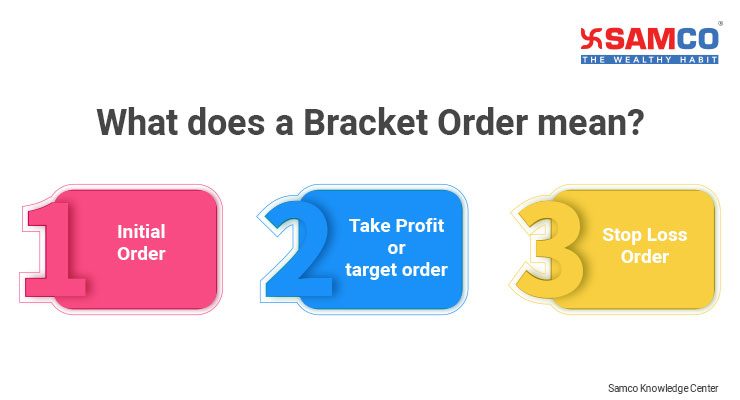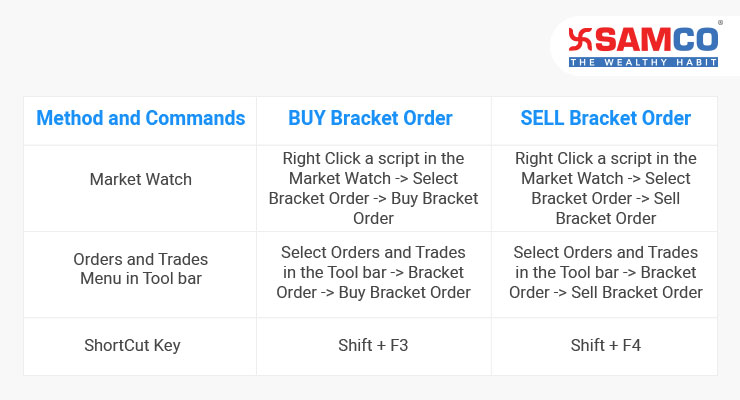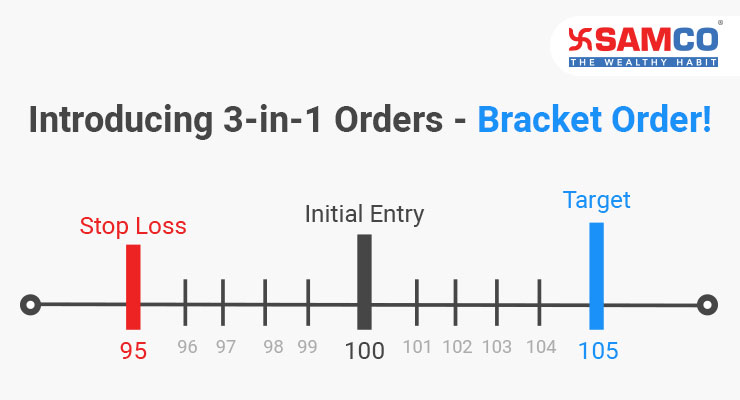What does a Bracket Order mean?

A Bracket Order in simple terms is a 3-in-1 order i.e. Target Order + Initial Order + Stop Loss Order in 1 ORDER. Bracket Order has 3 types of order embedded into 1 single order entry window. It is one of the most advanced types of order which involves auto cancellation and trailing stop losses.
The 3 types of orders embedded are:
- Initial Order – This is a limit order which is used to create the initial position
- Take Profit or target order – This is the order which is the target at which a trader would like to square off his position and take the profits
- Stop Loss Order – This is the order which is used to square off the position if the trade becomes unfavorable and limit the losses
Whenever the target order gets executed, the pending stop loss order gets canceled and vice versa. The target price, the order initiation price and the stop loss price creates a bracket and hence the name “Bracket Order”. A detailed understanding of Bracket orders can also be got on the Bracket Order Blog.
Bracket Order is strictly an intraday product and, if not squared off during the market hours, the Risk Management system will square off the order a few minutes before the market closure. In fact, it is the extended and advanced version of the cover order. The best feature about bracket order is that a trader can put the orders and be rest assured that either the Target order gets executed and gives him profit or the stop loss gets executed and the trade would be executed at a loss. There is no need to monitor the screen for booking a loss or profit.
In SAMCO Nest Trader, a client can right click on a script and select Bracket Order, or from the “Orders and Trades” menu select the Bracket Order Entry option or use the short cut keys Shift + F3 & Shift + F4 for buy and sell bracket orders respectively.
Placing A Bracket Order

You can place a bracket order by following the steps as mentioned in the appended table
Bracket Order Example
Let’s take a Bracket order example. Let’s say a client wishes to buy Infosys at Rs. 1,000 and wants to book profits at Rs. 1,050. However, he is afraid that it might go down a lot if it balls below Rs. 990. With normal orders, he would have to put
- A buy order with a limit price of Rs 1000
- A sell target order at Rs. 1050
- A Stop loss sell order at Rs 990.
Also, after putting the above orders he would have to monitor the trades to ensure that whenever any of the sell orders are triggered he cancels the other order. Else there is a possibility that all the 3 orders get executed.
With bracket order, in a single window, the trader can put all the above orders without having the need to monitor the price and cancel the 3rd order. The client has to put a buy order of Rs 1000, a target price of Rs. 50 & a stop loss of Rs.10. (Note that the target and stop loss price needs to be put as a different amount and not the actual price) Thus with a bracket order a lot of time and hassle is reduced.
The Bracket Order also comes with a unique feature where the client can trail his losses to minimize his losses and generate the best returns out of every trade. Suppose in the above order the client puts a trailing stop loss. Thus whenever the price of Infosys goes up by Re. 1, the stop loss also goes up by Re.1. However, the new stop loss remains unchanged if the price goes down. Thus, it moves up the stop loss and reduces the loss amount if the prices go southwards.
Bracket Order Margin
In Bracket Order, since the loss is covered as there is a compulsory stop loss, the margin requirements are similar to Cover Order and can be checked from the Bracket Order Margin Calculator.
Usually, the bracket order margins are the difference between the initial order and stop loss order multiplied by the quantity. This amount is obviously subject to a minimum margin which is a percentage of the initial order in order to provide a cushion in case of whipsaw trades and extremely small stop losses.
The initial order can be modified only if the trade has not been executed and the stop loss and target order can be modified any time before the position is squared off.
Since Bracket Order is a semi algo order, as per regulatory requirements it is not available on mobile devices.
Bracket Orders are available in the NSE Equity Segments, NSE Futures & Options Segments, NSE Currency Derivatives Segment & MCX segment. In MCX, it is currently available only under the Call and Trade facility.
Bracket Order vs Cover Order
While Bracket orders are an extension of cover orders, they have two major advantages over cover orders
- Target Orders – The ability to add target orders in the same order. Otherwise, in a cover order, target orders would be required to be entered separately. Also, the auto-cancellation of one leg of the order, if the order gets executed, is a feature that is absent in cover orders.
- Lower Margin requirements – In case of a bracket order, even though there may be 3 different orders, the margin applicable will be similar as in the case of cover orders. Whereas in cover orders, to place an additional leg of a target order, an additional margin would be applicable. Let’s take the above example of Infosys. The Bracket Order margin requirement would be (Initial order price – Stop Loss order price) * Quantity i.e. (1000 – 990)*500 assuming a lot size of Rs. 5000. Whereas in the case of cover orders the margin requirement would be Rs. 5,000 + the margin requirement for the target order i.e. roughly Rs. 60,000 with a total margin requirement of Rs. 65,000 for cover orders. So the bracket order actually frees up margin requirements of about Rs. 60,000 vis a vis cover orders.
You can place bracket orders with SAMCO on the SAMCO Trader.
In case you don’t have a SAMCO account yet, open a trading account and avail the benefits of bracket orders with SAMCO.





 Easy & quick
Easy & quick
Leave A Comment?